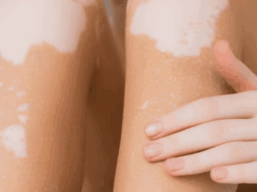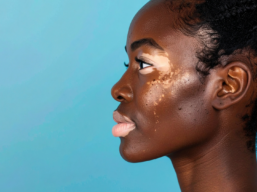
Finding Trusted Information About Vitiligo in a World of Misinformation
Introduction
If you search for information about vitiligo online, chances are you’ll land on a TikTok video, Instagram post, or personal blog before you reach a medical website. Social media has made health information easier to find, but it hasn’t always made it easier to trust. A recent study of TikTok’s most popular vitiligo videos shows that much of what people are watching is not medically accurate. At the same time, The Vitiligo Society’s own research reveals that people with vitiligo are struggling to know what information to believe.
In this blog, we explore what the research tells us, why misinformation spreads so easily, and how to find reliable sources of support.
What the 2025 TikTok study found
Researchers analysed TikTok videos tagged with “#Vitiligo” to see who was creating them, how accurate they were, and how people responded. The results were eye-opening.
Only about a quarter of the videos came from healthcare professionals such as dermatologists. These were the ones most likely to be accurate and useful. They explained what vitiligo is, outlined available treatments, and gave practical advice. Almost all of these professional videos were judged to be educational and 60% were rated high quality.
By contrast, the majority of videos came from non-professionals – people sharing their personal stories or unverified advice. These were much less accurate, with only around 13% rated as high quality. Yet they received far more likes and comments than the professional ones. In other words, videos with the most errors were often the most popular.
This shows a problem at the heart of social media health content: emotional stories and quick “tips” spread faster than careful explanations, even if they’re wrong.

Why misinformation takes hold
There are reasons why non-expert content is so appealing. Vitiligo is not just a medical condition; it affects self-esteem, relationships, and identity. Videos that share lived experiences or show positive body image can feel relatable and supportive. But when they are mixed with untested “cures” or misleading claims, they can cause harm.
For example, some companies have claimed endorsements from respected doctors or used the logos of patient organisations without permission. Vitistop, for instance, said it was supported by global vitiligo expert Dr Harris – something he has never agreed to. Another cream used the Global Vitiligo Foundation’s logo without approval. These tactics exploit trust, making it even harder for people to separate fact from fiction.
Community is central to the Vitiligo Society, and we strongly value the role of peer support in helping our members connect, share experiences, and recommend resources. Turning to fellow Vitiligans can often be one of the most effective ways to find reliable information and feel supported. However, we also recognise the risks posed by misinformation, particularly on online forums where individuals without medical expertise present opinions as facts.
As a charity, we often encounter the consequences of this, where people have attempted treatments such as unsupervised phototherapy or unverified creams they discovered online, leading to serious side effects or harm. This highlights the importance of ensuring that peer support is balanced with accurate, evidence-based guidance.
The Vitiligo Society’s research: the need for trusted sources
Our own research confirms that this confusion is widespread. In a 2023 survey of more than 700 people with vitiligo, 29% said they struggled to find information about their condition and 34% said they weren’t sure whether the information they found was accurate.
This uncertainty comes on top of the emotional burden vitiligo already carries. The condition is widely recognised as one of the most psychologically challenging skin conditions. People report impacts on confidence, self-esteem, and mental health. When trusted information is lacking, it adds another layer of stress – people are left wondering who to believe and whether they are making the right choices about treatment.
How to recognise trustworthy information
Different needs call for different types of information, but there are some clear signs that what you’re reading or watching is reliable. For medical advice and treatments, look for content that:
- Comes from or is endorsed by recognised organisations (e.g. NHS, WHO, The Vitiligo Society).
- References research, clinical trials, or established medical guidelines.
- Encourages you to consult your doctor before making decisions.
- Explains options clearly without promising quick fixes.
When it comes to lived experience, trustworthy sources are usually transparent about being personal perspectives rather than medical facts. They avoid making blanket claims or pushing unproven products.
Red flags to watch for include dramatic promises (“miracle cure”), unverified endorsements, heavy sales tactics, or websites and social accounts with no clear accountability.

Understanding clinical trials and licensing
One way to judge whether a treatment is credible is to ask if it has been through clinical trials and been licensed. Clinical trials are studies where new treatments are tested carefully to see if they really work and are safe.
In the UK, medicines and medical treatments must be approved by the MHRA (Medicines and Healthcare products Regulatory Agency) before they can be sold. Licensing shows that a treatment has met strict standards of safety and effectiveness.
If a product claims to be a miracle cure but has not been through clinical trials, or does not have MHRA approval, it’s important to ask why not. Without these safeguards, people risk wasting money, damaging their health, or being misled.
The risks of “DIY” treatments
Misinformation isn’t just about miracle creams. Some people are buying handheld UVB lamps online and using them for phototherapy at home without supervision. Phototherapy can help with vitiligo, but it should only be done under the care of a dermatologist. Without guidance, people risk burns, worsening of patches, and even long-term damage like skin cancer.
There are safe ways to access home phototherapy in the UK, such as NHS programmes like Vitiligo CARE, which provide training and support. The difference is supervision: a professional can adjust doses, monitor side effects, and decide when treatment should stop. Without that oversight, the risks outweigh the benefits.
The role of trusted organisations
The Vitiligo Society exists to cut through this noise. For more than 30 years, we have worked with experts and the community to provide accurate, accessible, and supportive information. Our free Definitive Guide to Vitiligo e-book explains the condition, outlines treatments, and offers advice for daily living. Our team is also available to answer questions and signpost to reliable services.
By becoming a member, you can support this mission and help us continue to challenge misinformation, share evidence-based resources, and raise awareness of vitiligo.
Conclusion: clarity over clicks
Social media has given a voice to people with vitiligo, but it has also made misinformation louder. Studies show that the most popular posts are often the least accurate, and our own research highlights how many people feel lost when searching for answers.
Finding trusted information matters. It protects people from harm, gives them realistic choices, and supports mental wellbeing. Whether it’s checking if a treatment has been trialled, looking for MHRA approval, or turning to trusted organisations, the key is to ask questions and demand evidence.
At The Vitiligo Society, we are committed to being a reliable source of truth and support. Together, we can make sure that trust, not hype, guides the conversation about vitiligo.
References
Bosslett M. The Most Popular Vitiligo Content on TikTok Lacks Medical Accuracy. Dermatology Times. 13 August 2025. Available at: https://www.dermatologytimes.com/view/the-most-popular-vitiligo-content-on-tiktok-lacks-medical-accuracy
Rosenberg H, Hollander Y, Gordon CB, Rotem R. Evaluating the Quality of TikTok Videos on Vitiligo: A Cross-Sectional Study. International Journal of Dermatology. 2025. PMID: 40698567.
The Vitiligo Society. Exploring Perceptions and Experiences with Vitiligo. November 2023.
The Vitiligo Society. The Definitive Guide to Vitiligo. 2023.
Please support our work! You've enjoyed 1 article this month and we hope you have found it useful. Our work is entirely funded by memberships and donations, so please consider joining our charity today and supporting our work.
Already a member? Log in





